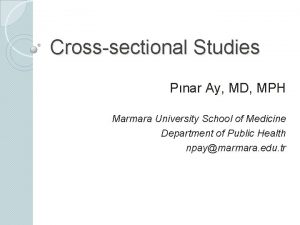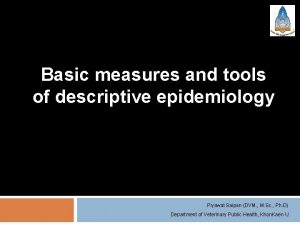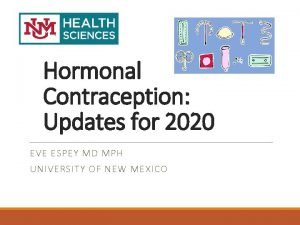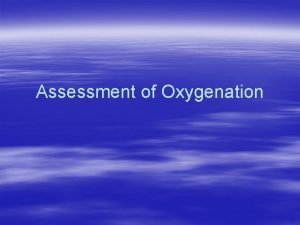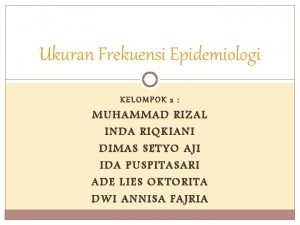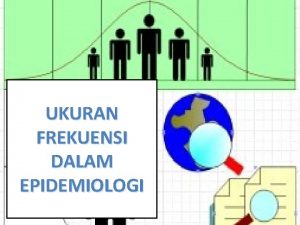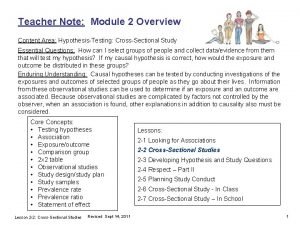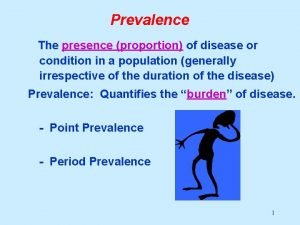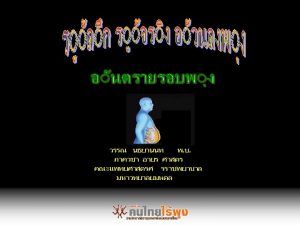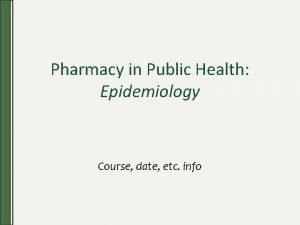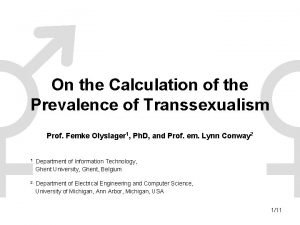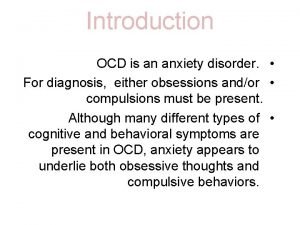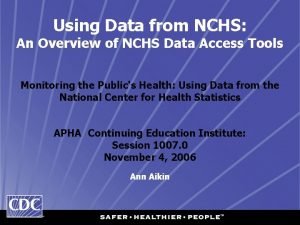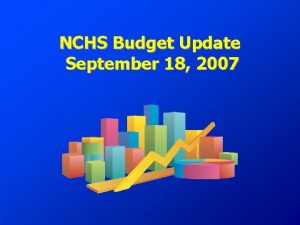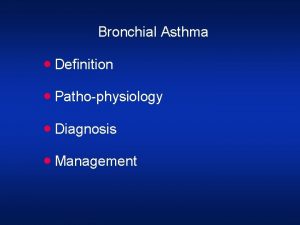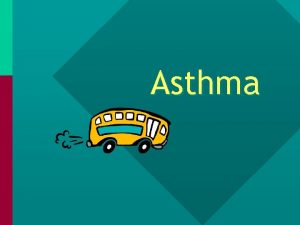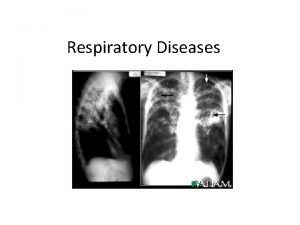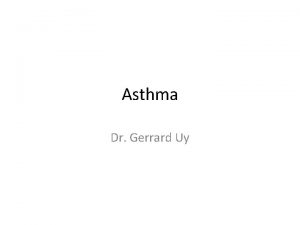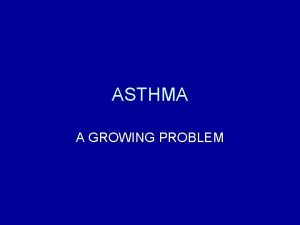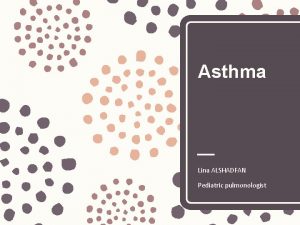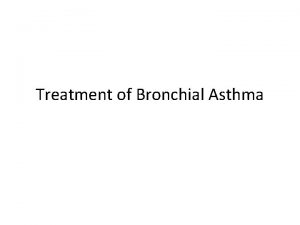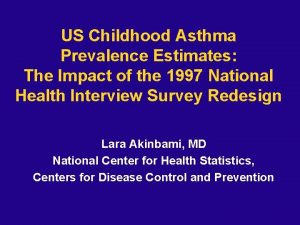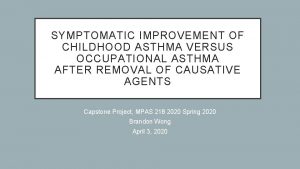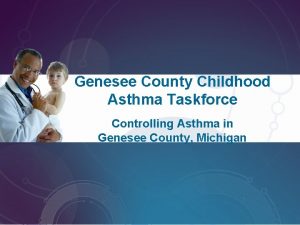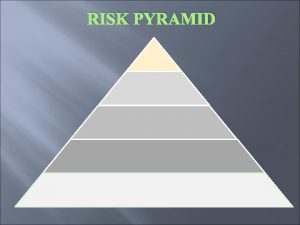Trends in childhood asthma NCHS data on prevalence





















- Slides: 21

Trends in childhood asthma: NCHS data on prevalence, health care use and mortality Susan Lukacs, DO, MSPH Lara Akinbami, MD Infant, Child and Women’s Health Studies Branch, NCHS, CDC

Asthma data available from NCHS data systems § Prevalence § Health care utilization § Ambulatory health care § Hospitalizations § Mortality

Asthma prevalence

National Health Interview Survey (NHIS) § Continuous multipurpose survey on health conditions, status and behavior § Representative sample of the noninstitutionalized civilian US population § Interviews in >40, 000 households – no review of medical records § Parent or responsible adult answers in proxy for children under 18 years of age § Redesigned in 1997 – affected asthma estimates

NHIS original and redesigned asthma questions 1980 -1996 Redesigned 1997 present Screener question: (None) Has a doctor or other health professional EVER told you that your child had asthma? Prevalence questions: During the past 12 mos, did anyone in the family have asthma? IF YES to “EVER? ”: During the past 12 mo, has your child had an episode of asthma or an asthma attack? Additional question 2001 -present IF YES to “EVER? ”: Does your child still have asthma?

Asthma prevalence, 1980 -96, asthma lifetime diagnosis, current and asthma attack prevalence, 1997 -2002: NHIS, children 0 -17 years Asthma lifetime diagnosis Current asthma prevalence Asthma prevalence (4. 3% per yr ) Asthma attack prevalence

Other asthma indicators available from the NHIS • 2002 asthma module – School days missed (trend established prior to 1997) – Preventive medications – Given asthma management plan by doctor – Advised by doctor to change home environment • 1999 asthma module (different questions) – Wheezing severity – Use of OTC and prescription medications

Average number school days a child with asthma missed per year, ages 5 -17 years: NHIS 1980 -2002 NHIS redesign * • Per child with asthma having > one asthma attack per year

Indicators of asthma control among children with current asthma, 2002 NHIS asthma module Ever taken preventive medication 65% Given management plan by MD 40% Advised to change environment by MD 48%

Asthma hospitalizations

Asthma hospitalizations for children 0 -17 years, 1980 -2002 National Hospital Discharge Survey (NHDS)

Asthma mortality

Mortality component of National Vital Statistics System (NVSS) § Death certificate data received by NCHS from 50 States and DC can obtain Statelevel data § Coding system changed in 1999 from ICD-9 to ICD-10

Asthma deaths, children 0 -17 years, 1980 -2000, NVSS ICD-9 ICD-10 ICD-9

Race/ethnic disparities in the burden of childhood asthma § Healthy People 2010 overarching goal § Examining disparities in asthma can guide policy and program decisions § However, issues in categorizing by race § New OMB guidelines: single vs. multiple race § Ethnicity not consistently available in data systems that rely on abstraction from medical records

Race/ethnic disparities in asthma attack prevalence, (1997 -2001 annual average), NHIS Non. Hispanic white Non. Hispanic black Hispanic Non-Hispanic black children had 30% higher asthma attack prevalence than NH white children

Race/ethnic disparities in asthma attack prevalence, (1997 -2001 annual average), NHIS Puerto Rican Non. Hispanic white Non. Hispanic black Hispanic Mexican

Racial disparities in asthma hospitalizations (2000 -2002 annual average), NHDS Black White Black children had 240% higher hospitalization rate than white children

Race/ethnic disparities in mortality (19992001 annual average), NVSS Non. Hispanic black Non. Hispanic white Non-Hispanic black children had 350% higher asthma death rate than NH white children Hispanic

Summary on trends in childhood asthma § Prevalence, health care use, and mortality increased through the mid 1990 s § Since the mid 1990 s, prevalence, ambulatory health care use, hospitalization and death rates have plateaued § Minority children bear a higher asthma burden § Racial disparities are most pronounced for preventable outcomes, such as ER visits, hospitalization and death

For additional information on asthma from the CDC § NCHS home page: http: //www. cdc. gov/nchs/ § Asthma Health E stat: asthma prevalence, health care use and mortality for all ages in 2002 § Summary statistics from the NHIS for children, 2002 § National Center for Environmental Health: http: //www. cdc. gov/nceh/airpollution/asthma/ § Behavioral Risk Factor Surveillance Survey: state level asthma prevalence for adults § Links to asthma-related reports in the Morbidity and Mortality Weekly Report, including the Asthma Surveillance Summary, 1980 -1999
 Period prevalence vs point prevalence
Period prevalence vs point prevalence Percentage defination
Percentage defination Period prevalence vs point prevalence
Period prevalence vs point prevalence Period prevalence vs point prevalence
Period prevalence vs point prevalence Pathology of asthma
Pathology of asthma Nchs
Nchs Nchs
Nchs For teen
For teen Nchs
Nchs Middle childhood and adolescence
Middle childhood and adolescence Trends in early childhood education
Trends in early childhood education Objective data for asthma
Objective data for asthma Contoh soal prevalensi dan insidensi
Contoh soal prevalensi dan insidensi Morbiditas adalah
Morbiditas adalah Obesity prevalence europe
Obesity prevalence europe Prevalence ratio
Prevalence ratio Prevalensi adalah
Prevalensi adalah Prevalence of obesity
Prevalence of obesity Calculate prevalence rate
Calculate prevalence rate Prevalence calculation
Prevalence calculation What is incidence
What is incidence Ocd symptoms checklist
Ocd symptoms checklist


